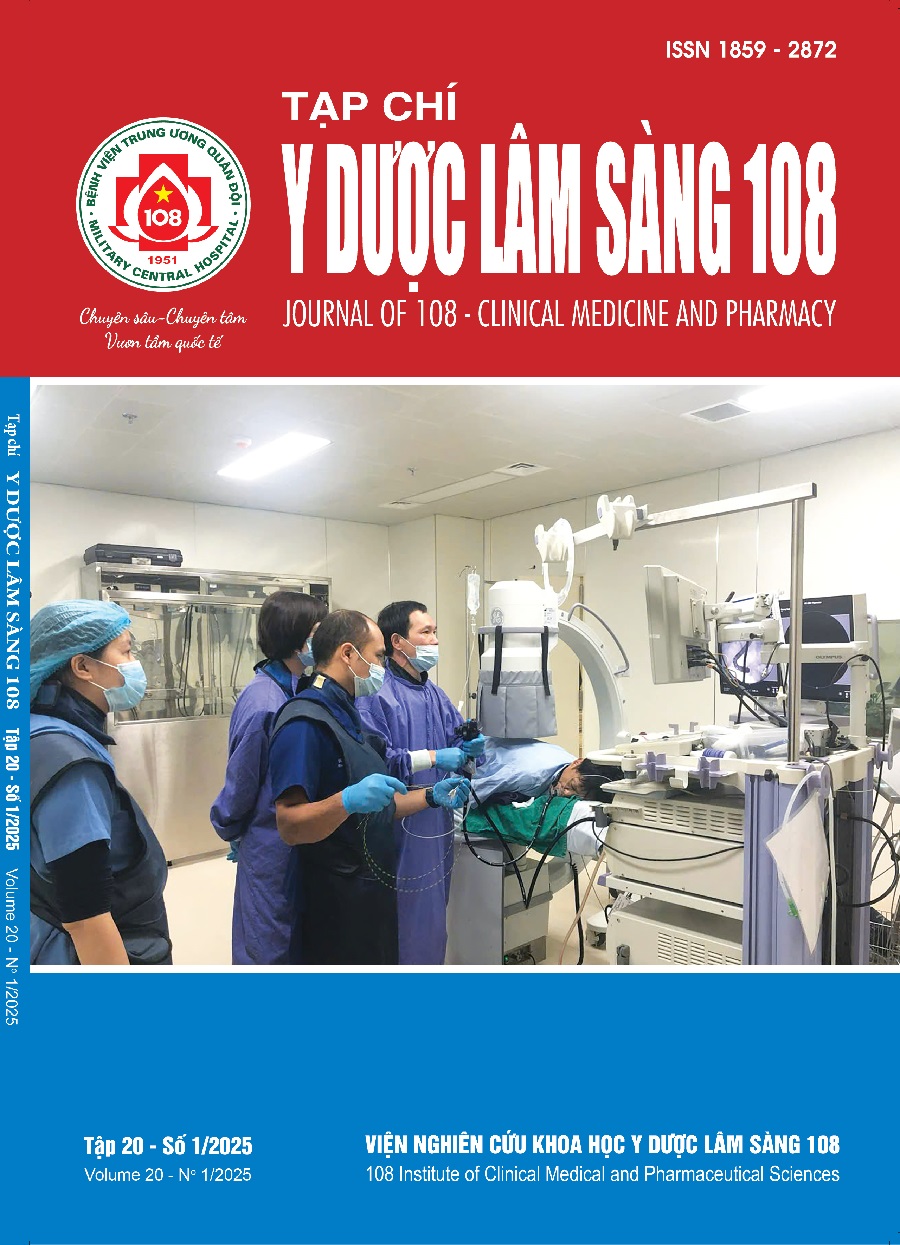Initial results of left bundle branch area pacing compared to right septal ventricular pacing in patients with atrio-ventricular block
Main Article Content
Keywords
Abstract
Objective: To compare initial results of left bundle branch area pacing (LBBAP) to right septal ventricular pacing (RSVP). Subject and method: 104 patients with atrio-ventricular block who have indications for 2 chamber cardiac pacing underwent LBBAP (52 patients) and RSVP (52 patients). Endpoints: To compare the results of procedural time, fluoroscopy time, ventricular lead implantation time, major periprocedural complications; electrocardiographic characteristics, pacing parameters. Result: The average procedural time of LBBAP group was 74.38 ± 20.52 minutes, significant longer than 51.65 ± 6.79 minutes of RSVP group (p<0.001). The median of fluoroscopy time of LBBAP group was 10.95 (8.65; 14.25) minutes, significant longer than 6.3 (4.8; 8.0) minutes of RSVP group (p<0.001). 49/52 patients got successfully LBBAP and 52/52 patients successfully underwent RSVP. Paced QRS in successful LBBAP group was 112.67 ± 13.47 ms, significantly shorter than 145.85 ± 9.49 ms of RSVP group (p<0.001). Pacing thresholds were similar between the groups (0.84 ± 0.24 V/0.4 ms of successful LBBAP group compared with 0.75 ± 0.24 V/0.4 ms of RSVP group; p=0.07). 3/52 cases of the LBBAP group got an intra-procedural septal perforation requiring reposition. No major complications. Conclusion: LBBAP is superior to RSVP in terms of electrical synchronization but procedural time and fluoroscopy time are longer. No major complications in both groups.
Article Details
References
2. Chung MK, Patton KK, Lau CP et al (2023) 2023 HRS/APHRS/LAHRS guideline on cardiac physiologic pacing for the avoidance and mitigation of heart failure. Heart Rhythm 20(9): 17-91.
3. Burri H, Jastrzebski M, Cano Ó et al (2023) EHRA clinical consensus statement on conduction system pacing implantation: Endorsed by the Asia Pacific Heart Rhythm Society (APHRS), Canadian Heart Rhythm Society (CHRS), and Latin American Heart Rhythm Society (LAHRS). Eur Eur Pacing Arrhythm Card Electrophysiol J Work Groups Card Pacing Arrhythm Card Cell Electrophysiol Eur Soc Cardiol 25(4): 1208-1236.
4. Sharma PS, Dandamudi G, Naperkowski A et al (2015) Permanent His-bundle pacing is feasible, safe, and superior to right ventricular pacing in routine clinical practice. Heart Rhythm 12(2): 305-312.
5. Bhatt AG, Musat DL, Milstein N et al (2018) The Efficacy of His Bundle Pacing: Lessons Learned From Implementation for the First Time at an Experienced Electrophysiology Center. JACC Clin Electrophysiol 4(11): 1397-1406.
6. Vijayaraman P, Subzposh FA, Naperkowski A et al (2019) Prospective evaluation of feasibility and electrophysiologic and echocardiographic characteristics of left bundle branch area pacing. Heart Rhythm 16(12): 1774-1782.
7. Glikson M, Nielsen JC, Kronborg MB et al (2021) 2021 ESC Guidelines on cardiac pacing and cardiac resynchronization therapy. Eur Heart J 42(35): 3427-3520.
8. Jastrzębski M, Kiełbasa G, Curila K et al (2021) Physiology-based electrocardiographic criteria for left bundle branch capture. Heart Rhythm 18(6): 935-943.
9. Jastrzębski M, Burri H, Kiełbasa G et al (2022) The V6-V1 interpeak interval: A novel criterion for the diagnosis of left bundle branch capture. Eur Eur Pacing Arrhythm Card Electrophysiol J Work Groups Card Pacing Arrhythm Card Cell Electrophysiol Eur Soc Cardiol 24(1): 40-47.
10. Chen Z, Xu Y, Jiang L et al (2023 Left Bundle Branch Area Pacing versus Right Ventricular Pacing in Patients with Atrioventricular Block: An Observational Cohort Study. Cardiovasc Ther: 6659048.
11. Li Y, Chen K, Dai Y et al (2019) Left bundle branch pacing for symptomatic bradycardia: Implant success rate, safety, and pacing characteristics. Heart Rhythm 16(12): 1758-1765.
12. Vijayaraman P, Bordachar P, Ellenbogen KA (2017) The Continued Search for Physiological Pacing: Where Are We Now? J Am Coll Cardiol 69(25): 3099-3114. doi: 10.1016/j.jacc.2017.05.005.
13. Olshansky B, Day JD, Sullivan RM, Yong P, Galle E, Steinberg JS (2012) Does cardiac resynchronization therapy provide unrecognized benefit in patients with prolonged PR intervals? The impact of restoring atrioventricular synchrony: An analysis from the COMPANION Trial. Heart Rhythm 9(1): 34-39.
14. Sato T, Togashi I, Ikewaki H et al (2023) Diverse QRS morphology reflecting variations in lead placement for left bundle branch area pacing. EP Eur 25(9): 241.
15. Upadhyay GA (2023) QRS morphologies in V1 and V6 during left bundle branch area pacing: assessing the patterns. Europace 25(9): 284.
16. Zhang S, Guo J, Tao A, Zhang B, Bao Z, Zhang G (2021) Clinical outcomes of left bundle branch pacing compared to right ventricular apical pacing in patients with atrioventricular block. Clin Cardiol 44(4): 481-487.
 ISSN: 1859 - 2872
ISSN: 1859 - 2872
